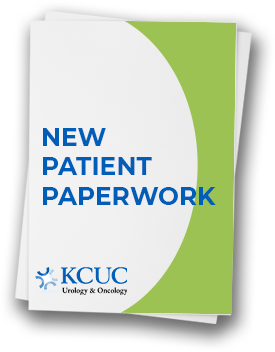Benign Prostatic Hyperplasia (BPH) is a common, benign condition, generally found in older men in which the prostate gland enlarges. The prostate is normally a walnut-sized gland that produces semen, the fluid that transports sperm. It is located below the bladder and surrounds the urethra (the tube carrying urine out of the body). When the prostate enlarges it can compress the urethra and cause obstruction of the urinary outlet. This often results in a slow stream, incomplete emptying, and frequent urination.
With over 20 experienced urologist office locations in Kansas and Missouri, the doctors at KCUC proudly offer local treatment for enlarged prostates and Benign Prostatic Hyperplasia in Kansas City, Overland Park, Emporia, Leavenworth, Clinton, Liberty, Olathe, Harrisonville, Independence, MO, and the entire KC metro area.
Causes of Benign Prostatic Hyperplasia (BPH)
Benign Prostatic Hyperplasia is believed to be related to the aging process and the presence of the male hormone testosterone. More than half of men age 50 and older and 90 percent of men age 80 and older have BPH. About one in every four men require treatment for BPH.
Symptoms of BPH
An enlarged prostate or BPH can cause a variety of urinary symptoms including:
- Urge – sudden need to urinate
- Frequent urination, especially at night
- Weak or interrupted urine stream
- Difficulty starting urination
- Urine leakage (incontinence)
- Inability to completely empty the bladder
- Blood in the urine (hematuria)
- An elevated PSA (prostate specific antigen)
Caffeine, alcohol, spicy or acidic foods, certain cold medications, and constipation can make symptoms worse. Left untreated, symptoms may worsen over time and can cause complications that may include the inability to urinate (urinary retention), bladder or kidney damage, bladder stones, or urinary infections.
Diagnosis of BPH in Kansas City
Your Kansas City BPH doctor will take a medical history and do a physical exam. A digital rectal exam (DRE) and AUA urinary symptom score will be performed. Your doctor may order a bladder scan to check for post-void residual urine. Sometimes a voiding flow rate or urodynamic testing may be needed to help accurately diagnose the problem. Cystoscopy (looking into the bladder with a scope) may also be needed to help identify the cause of obstruction. A prostate-specific antigen (PSA) test should be checked to exclude prostate cancer, which in the later stages can cause urinary obstruction.
Treatment for Benign Prostatic Hyperplasia
Treatment will depend on the severity of your symptoms and how much they interfere with your lifestyle. Treatments vary from watchful waiting to surgical procedures. Men with minimal symptoms may only need to make lifestyle changes; those with more pronounced symptoms or complications may benefit from medication or a procedure. Your doctor can help you determine which treatment is most appropriate for you.
Lifestyle Changes (watchful waiting)
- Avoid caffeine, acidic drinks such as colas, tomato and orange juice, and alcohol. Cold medications containing antihistamines or pseudoephedrine, can make it more difficult to urinate. Constipation can also worsen symptoms.
- Limit evening beverages if night time-frequency is a problem.
- Healthy diet and good physical conditioning can be of benefit.
Medications
When symptoms progress and watchful waiting is no longer acceptable then medications are often the next best option.
Medications may include:
- Alpha blockers to relax the smooth muscle tissue in the bladder neck and prostate, increasing urinary flow (examples are tamsulosin and doxazosin)
- Five alpha reductase inhibitors which shrink the prostate by preventing the conversion of testosterone to dihydrotestosterone, a testosterone metabolite which can cause prostate enlargement
- Anti-cholinergics (bladder relaxant) to reduce frequency and urgency
Minimally Invasive Therapy
When medications are not effective BPH management then additional work up like cystoscopy or urodynamics may be beneficial to help further characterize the cause for lower urinary tract symptoms (LUTS) After testing your urologist may suggest a prostate procedure. These procedures seek to open a passage through the prostate to allow urine to flow with less effort. Many are called “transurethral” because instruments are passed through the opening at the tip of the penis and into the urethra. Your urologist will perform the most advanced treatment for enlarged prostate, aka BPH, using the least invasive technique appropriate to resolve your problem.
- Transurethral needle ablation with steam (REZUM) — A small needle is inserted into the obstructing BPH and heated with hot water vapor.
- Laser vaporization — (Greenlight or CyberTM) laser energy delivered through a small quartz fiber heats and vaporizes the obstructing prostate tissue.
- Transurethral incision of the prostate – electrocautery or laser is used to make an incision through the prostate and bladder neck.
- Transurethral resection of the prostate (TURP) — obstructing tissue is removed (shaved with an electrocautery loop through a specialized cystoscope. This technique is more invasive than the preceding techniques, but still considered the most effective. Urologists still use the results from the TURP as the standard by which other BPH treatments are compared.
- Prostatectomy — open procedure to remove the obstructing prostate; a rarely done option reserved for those with very large prostates.

